But I'm a watercolor artist!
Some thoughts on adapting my art practice to the weather and getting out of my comfort zone
I love painting en plein air and urban sketching. As much as possible, I prefer to work from life for my paintings. During the freedom of my teacher’s summer, I got out as much as I could, at least once a week, usually more, persisting even through the hottest of our heatwaves.
And then the school year began, and the weather turned dreamy and perfect. From the large windows of my classroom, I can look out on the lush campus and brilliant blue sky, and wish I were out there with my easel and paints. I’m generally thankful to have such a great day job. I don’t have to put any pressure on my creative pursuits to pay the bills, I do work that is meaningful, and I am able to make time for art. But in September, I had some real FOMO as the plein air groups to which I belong went on lovely excursions to picturesque farms and seaside towns. The first couple months of a school year are so frenzied that even on the weekends, I couldn’t get out much, to my great dismay.
Now the leaves are turning, the light is golden, and the temps are dropping, and in the past couple of weeks, I have found some little holes in my busy calendar where I could grab my kit for some location sketching. Each time I have set out ready for the joyful act painting under the cerulean sky of fall, and each time I have wound up frustrated and annoyed.
Often, unfortunately, I start from a place of annoyance because I have a limited amount of time, always less time than I really want. For me, a good session is about two and a half hours. I know I should be grateful when I can carve out forty-five minutes, but that pang of annoyance is always lurking just under the surface. I find myself rushing and feeling stressed before I even begin, fumbling with materials and impatient in my hunt for a subject.
And then there’s the challenge of the cooler temps. I need to sketch quickly due to my lack of time, but the watercolor washes dry slowly when the temperature drops below 65 degrees, and anything I do to rush that will only result in a mess. So I make a mess, knowing all the while exactly what I am doing, and then I am annoyed with myself.
And—worse—before I inevitably make the mistake of using too-wet washes and not waiting long enough for them to dry, I had been reminding myself to use a different approach. Try line and wash, I tell myself, so that the watercolor can just go on lightly at the end. Use other media, I tell myself, like colored pencil or charcoal or pastel to avoid the problem of drying time.
But when I get to a location and start to work, I can’t seem to stop myself from grabbing my watercolor, as I wrote about in my post about a recent rainy plein air competition. Since that competition, to try to expand my comfort zone, I’ve been practicing at home with pastels and charcoal, and I have loaded my sketching bag down with more and more supplies. I’ve basically got my whole studio in there. But still, when I feel the (entirely self-induced) pressures of producing art in the wild, I can’t seem to help myself. I default to my same old bag of tricks. There are enough challenges to location sketching without working in an unfamiliar media, and so, as long as my watercolor palette is in my kit, I find myself reaching for it.
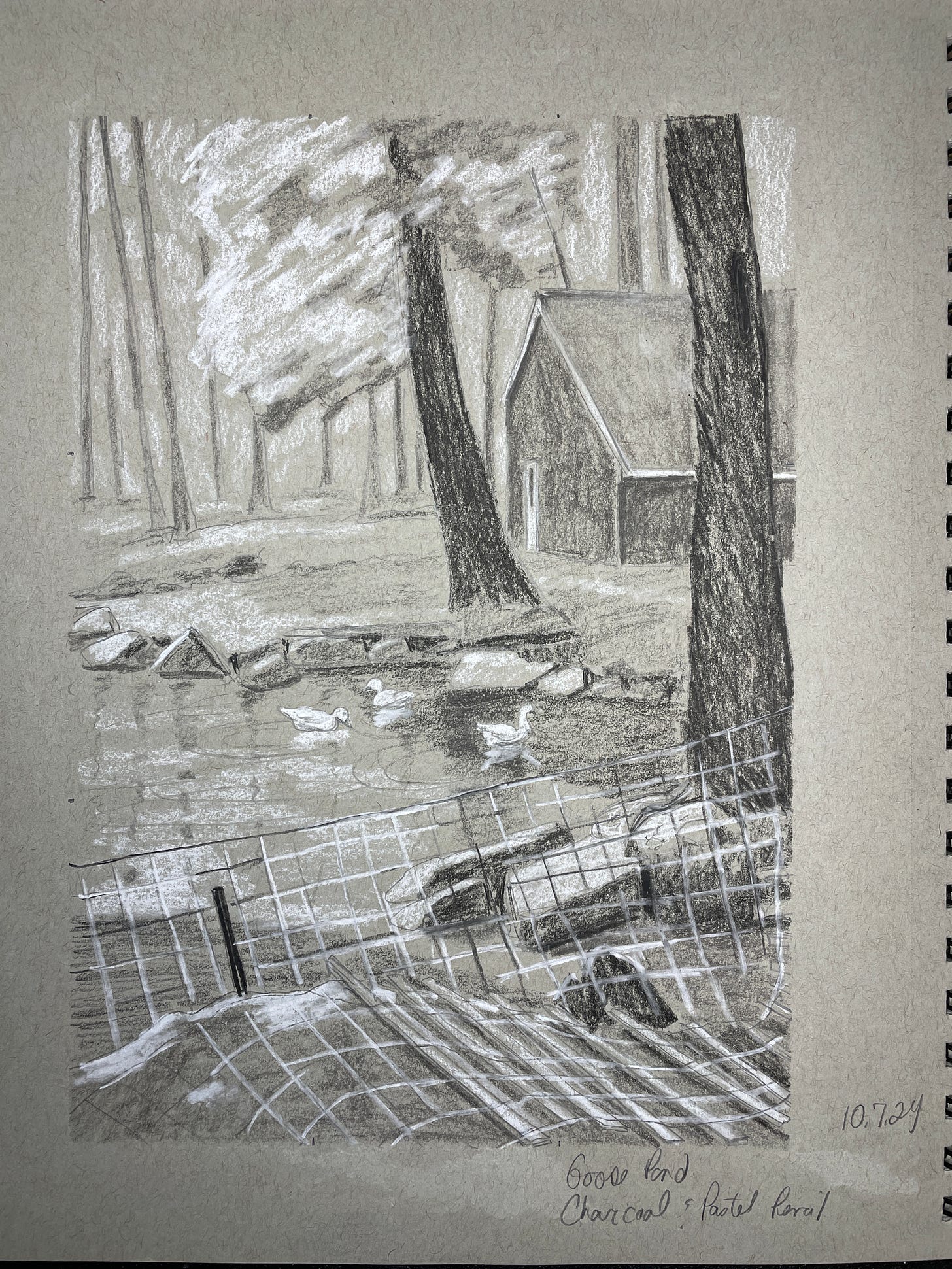
Finding a way past frustration
Last week, after my third “ruined” sketch in a row, I was starting to feel like my new sketchbook was cursed. Everything I did in it turned to mud. I had to fight the temptation to rip a page right out of it and hide all evidence of my failure. In the past, even when a sketch wasn’t all I hoped it would be, I never even considered tearing it out, but it took all my strength to leave this recent mess in place.
Of course it’s not my sketchbook’s fault. It’s my favorite brand, which I’ve used for two years now with beautiful, 100% cotton paper. There’s nothing wrong with the book. The problem is my own failure to adapt to the season, my desire to stay in my comfort zone, the limited definition I have put on myself, not “artist” but “watercolor artist,” and the feeling that I have to be making “real art” with the precious moments I have for plein air these days.
So this week I took a drastic step: I took my watercolor palette out of my sketching bag and narrowed my kit down to a sketchbook, some fine liners, Inktense pencils and a water brush. My theory: The best way to fix my mindset was to limit my options to force myself to try something new.
This choice of tools solved the issue of adapting to the season. Because Inktense can be used dry like regular colored pencils or wet like watercolor pencils—with the difference that Inktense dries permanent whereas the pigment of watercolor pencil can be repeatedly reactivated—I knew they would be better for cool weather. A water brush would allow me to soften the pencil marks and to lay down tone quickly but would not saturate the page so the layers will actually dry.
I hoped solving that problem would free me up to fix my attitude. Forcing myself outside my comfort zone—I have very little experience with colored pencil or water soluble pencil—I was hoping to shake off the worry of making “real art” and return to the joyful approach of playing with materials with a spirit of curiosity and discovery.
Swapping my watercolors for water-soluble Inktense pencils
My first sketching session with my pared down kit was on a quick errand to Rhode Island. Have made the hour-long drive to pick up some paintings from a gallery, I decided I would sketch before heading home, but I only had about 45 minutes if I wanted to avoid the worst of rush hour traffic.
Because the gallery was in a park that I’ve visited several times, I had a subject in mind when I arrived, a bandstand on a small pond. Given my inexperience with Inktense, I kept it simple, planning to use only a pair of complementary colors: indigo blue and tangerine orange. As I got started with the basic composition, though, I felt uncertain which color to use where, so I decided to use only one color, indigo, instead.
I was quickly absorbed in the task, happily exploring some mark-making and seeing what textures the water brush could achieve. When I was nearly done, I was tempted to be brave and add a couple of dashes of orange. I put down some very light strokes of pencil, but as I swished the brush over them, I panicked, uncertain I had made the right decision. I dabbed with my paper towel and lifted most of the orange away, leaving just a hint on the places where the light is strongest.
The completed piece is a sketch in the true sense of the word. I didn’t include any background, only the foreground grasses, the willow tree, and the bandstand. Despite its unresolved quality, I like the sense of movement and light that comes through and for the first time in a few weeks, I felt joyful as I shut my sketchbook.
Sketches in Inktense from a weekend away
The real test of my Inktense urban sketching kit came on a long weekend on Cape Cod. Saturday afternoon the weather was gorgeous when I set out to do some drawing. Funnily enough it was actually ideal watercolor weather, but of course I didn’t have my watercolors with me. In hunting for a subject to sketch, my first requirement was that I had to find shelter from the wind, so the beach was out. Instead, I walked toward a conversation area. From the parking area I spotted this rambling, classic New England farm house and massive beech tree. The afternoon sunlight was making interesting shadows on the house and the tree was a masterpiece in its own right. I had no time constraints to deter me from the complex scene, so I set up my tripod easel and got to work.

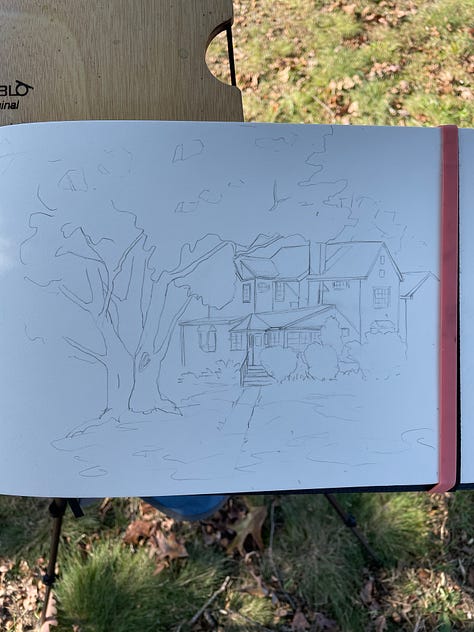
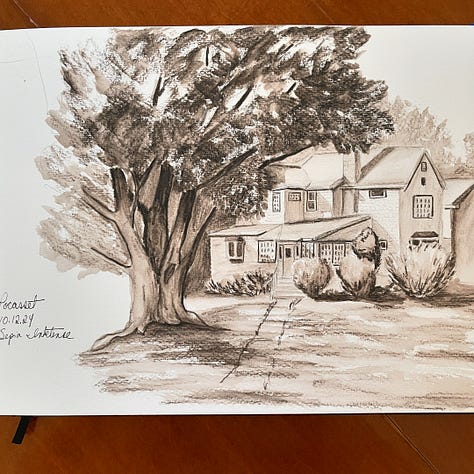
I decided, once again, to stick with a monochrome approach. When it comes to watercolor, I consider myself a colorist. I love color, and I love mixing my own colors. But with Inktense pencils, I’m not sure how mixing colors works. It’s something I need to explore more.
So on this day, instead of frustrating myself with color, I used sepia and focused on values. I definitely found it tricky to get a range of values with Inktense pencils. They are really good at putting down dark values, and it’s possible to put down a very thin layer for the lightest values, but it takes some finesse to get a spectrum of midrange values.
Something I really enjoyed in this sketch was how I could create textures for the leaves and shadows on the grass by leaving some areas dry and wetting others. In total, this sketch took about two hours and induced no annoyance on my part. A victory, indeed!
The next day was cold and drizzly, exactly the sort of weather I had in mind when changing up my kit, but a series of events conspired to prevent me from location sketching. That said, I did manage to hunt some locations and take reference photos. Back at the house, I camped out at the dining room table and did this sketch of the famous Cape Cod Canal Railroad Bridge.
It was such a gray and gloomy, there was no real color to revel in down by the canal when I took my photos, so I decided to keep going with monochrome. I don’t know what made me chose oxide red, other than the fact that it’s a beautiful warm color. Maybe I was wishing for warmth. The drawing alone took me well over an hour—there’s an awful lot of perspective in there!—but the Inktense went down pretty fast to add tone and create volume.
Speed was one of my concerns when leaving my paints at home. Watercolor washes go down so quickly. You can cover big areas very fast. Colored pencil, in my experience, is much slower. What I’ve discovered in these sketches, however, is that leaving the white of the page makes a powerful statement, and because I am only applying color in relatively small areas, I can move quite quickly. The total time on this one was about two hours.
So what’s next?
I’m enjoying using Inktense immensely. Instead of trying to make watercolor behave against its nature, I’ve adapted to the season and my frustration has evaporate. I’m leaning into my illustrative style instead of trying to be “painterly,” and as a result, I’m learning a lot and having fun in the process.
I want to try full color sketches with Inktense at some point, but maybe my next steps will be exploring sketches using complementary and analogous color schemes. Actually, learning to “ignore” the colors in front of me and play with other palettes is good for my goal of being less literal and more expressive, so there’s no need to rush toward “accurate” color sketches.
What’s next, I guess, is more play and curiosity!
How do you adapt your art practice to the seasons? Have you tried Inktense pencils? Share in the comments!



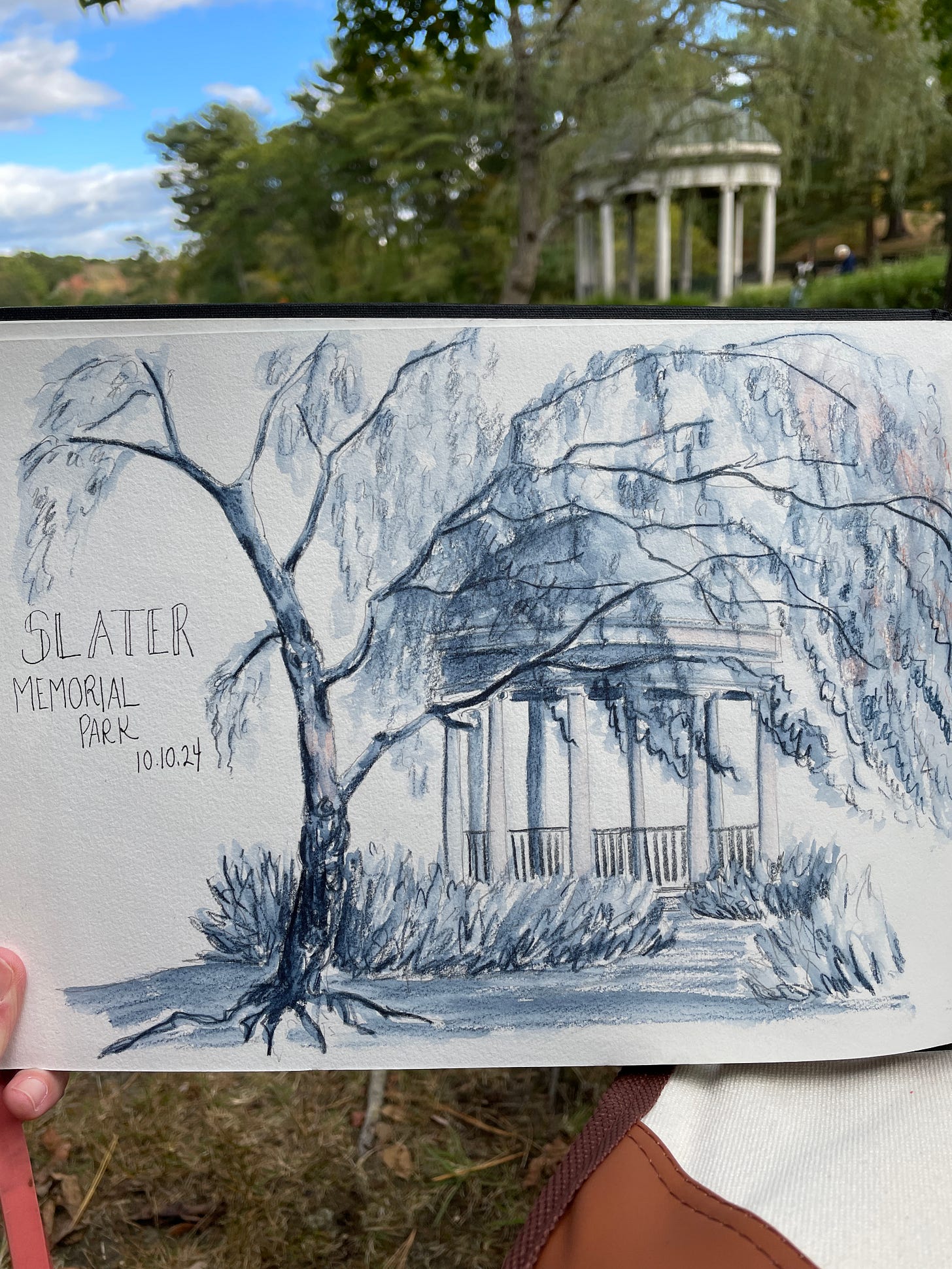
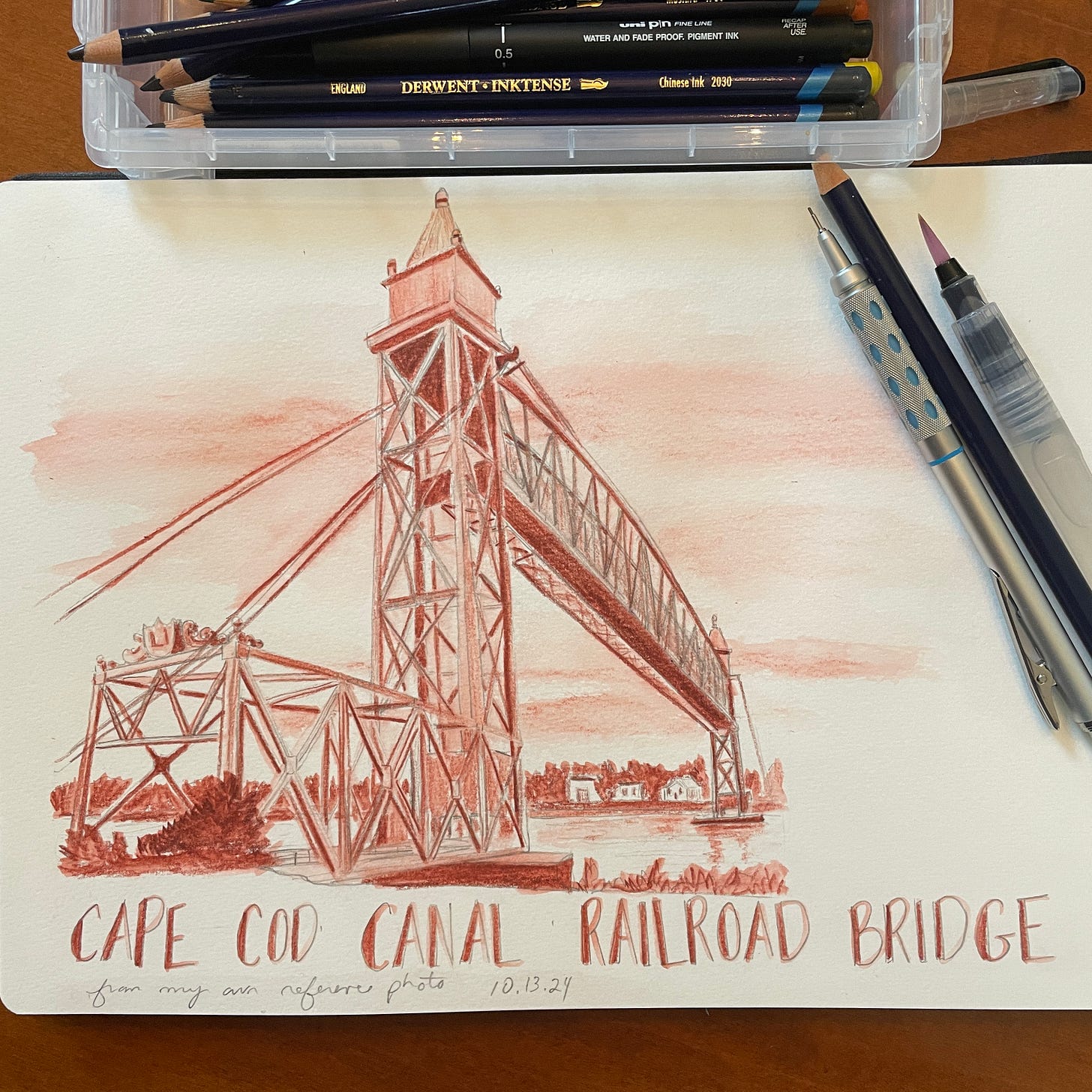
Really enjoyed this!
I love how you adapted your media to support your work style. I love ink tense pencils. Sometimes, I don't even carry them with me. I just scribble a thick spot of each color on a separate page and rub my wet brush against them when on site. Thank you for sharing your insights